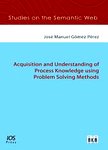版权所有:内蒙古大学图书馆 技术提供:维普资讯• 智图
内蒙古自治区呼和浩特市赛罕区大学西街235号 邮编: 010021

丛 书 名:Studies on the Semantic Web
版本说明:1
I S B N:(纸本) 9781607506003
出 版 社:IOS Press Incorporated
出 版 年:2010年
页 数:154页
主 题 词:Knowledge acquisition (Expert systems) Problem solving -- Data processing
学科分类:12[管理学] 1201[管理学-管理科学与工程(可授管理学、工学学位)] 081104[工学-模式识别与智能系统] 08[工学] 0835[工学-软件工程] 0811[工学-控制科学与工程] 0812[工学-计算机科学与技术(可授工学、理学学位)]
摘 要:The development of knowledge-based systems is usually approached through the combined skills of knowledge engineers (KEs) and subject matter experts (SMEs). One of the most critical steps in this activity aims at transferring knowledge from SMEs to formal, machine-readable representations, which allow systems to reason with such knowledge. However, this is a costly and error prone task. Alleviating the knowledge acquisition bottleneck requires enabling SMEs with the means to produce the desired knowledge representations without the help of KEs. This is especially difficult in the case of complex knowledge types, like processes. The analysis of different application domains uncovers that process knowledge is one of the most frequent knowledge types, whose complexity requires specific means to enable SMEs to represent processes in a computational form. Additionally, such complexity and the increasingly large amount of data that process executions generate in knowledge-intensive domains, like Biology or Astronomy, requires analytical means with high abstraction capabilities to support SMEs in the analysis of such processes. This book presents methods and tools that enable SMEs to acquire process knowledge from the domains, formally represent such knowledge, reason about it, and understand process executions by analyzing their provenance. We describe the utilization of Problem Solving Methods as the main knowledge artifacts for process acquisition and analysis in two innovative ways. First, as formalizations of the reasoning strategies needed for processes and, second, as high-level, domain-independent, and reusable abstractions of process knowledge to provide SMEs with interpretations of process executions.